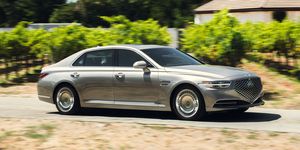You’ll get used to the grille of the Genesis G90. That’s our prediction in this, the era of Peak Grille, when the looming prospect of homogeneous, bullet-prowed EVs seems to have precipitated a run on egg crates and mesh. Everywhere you look, grilles are engulfing whole front ends, threatening to run up the hood and swallow the fenders, and the first look is always shocking. But the more of these megalodon maws you see, the less off-putting each one becomes. To get noticed now, you need to roll with a crest grille. That’s what Genesis calls the sprawling five-sided hunk of latticework affixed to the front end of the updated 2020 G90. If this pentagon were any bigger, five-star generals would show up for work at it.
With former Bentley design chief Luc Donckerwolke in charge of styling at Genesis (and, indeed, the whole Hyundai group), the G90 is no cautious, vaguely handsome pastiche of Euro styling cues. It’s brash, actually. This is an unusually ambitious mid-cycle refresh, to the point that the only carryover exterior panels are the doors and roof. Check out those wheels, looking like they were machined from a solid chunk of attitudinum. They’re actually functional, too—you know, beyond being round and holding a tire in place. The face of each wheel is friction-welded to the ring (the barrel part of the wheel), creating a circular resonance chamber between the two weld faces. That chamber includes holes that empty into the tire volume, helping to cancel tire noise in the 190- to 220-hertz range. As a bonus, the two-piece construction saves seven pounds per wheel. This is one case where you might actually let the dealer sell you those wheel locks.
Park the big Genesis next to a Hyundai Equus, as we happened to do in a grocery store lot, and it’s hard to believe that the G90 is the Equus’s immediate successor. It seems like the two models should have at least a decade and half between them, but the Equus was displaced by the G90 only in 2017. Not everybody’s going to find the G90 handsome, but its confident extroversion seems to provoke a begrudging admiration even in those who find the wheels or the grille a bit too up-and-coming strongman for their taste.
Familiar Opulence
Inside, the updates are more subtle. There’s a new 12.3-inch touchscreen and compatibility with Apple CarPlay and Android Auto. Maps and software can now get over-the-air updates. And the driver-assist systems have learned some new tricks, such as lane-following assist (lane centering, really), which does a good job avoiding the ping-pong sensation of some other lane-keeping systems. Safe-exit assist warns you when an object is approaching an opening door, which makes us think somebody at Genesis rides a bike in the city.
If the exterior is provocative, the interior is serene. It offers all the tactile accoutrements you’d expect—nappa leather, open-pore wood, real chrome plating on the switches—but it doesn’t evidence the ambition of the latest Mercedes-Benz interiors (see: heated armrests, augmented-reality navigation). And maybe that’s okay. There’s an audience for simplicity that prefers knobs and buttons over touchpads and gesture-control screens. The G90’s rear-seat passengers have it really good, with the ability to commandeer both the media system and the climate controls. The front passenger seat even has fore and aft buttons facing rearward, so that the right rear passenger can scoot the front seat forward. The G90 is well equipped to test the power dynamics within your family.
The One to Get
Powertrains go unchanged for the 2020 model year, including a standard 365-hp turbocharged 3.3-liter V-6 and a 420-hp 5.0-liter V-8 as a $3500 option. An eight-speed automatic transmission continues to back up either engine. The hushed, torque-rich V-6 is so well suited to the G90’s easygoing demeanor that it seems like a no-brainer to trade two cylinders for two turbos here.
Need more arguments for the V-6? In our testing, our rear-wheel-drive, V-6–powered test car’s 5.0-second run to 60 mph makes it essentially just as fleet as the quickest V-8 model that we’ve had at the test track. It also earns a better EPA fuel economy rating: 20 mpg combined versus 19 mpg for a rear-drive G90 with the 5.0-liter. Subtract 1 mpg from the V-8’s estimate with all-wheel drive. And did we mention the V-6 costs $3500 less? The 2020 G90 starts at $73,195, a figure that’s about $20K less than a Mercedes S-class, and you may as well maintain that delta because this is a sedan that doesn’t feel like it needs any additional options. Genesis must feel the same way, because aside from the no-cost paint and interior colors, the options list is blank.
With either engine, the G90 is quick but not playful. The stability control system, even when deactivated, lurks in the background, ready to quash any tail-out hijinks. Hey, whose kid—or grandkid—got the keys? The ride is floaty or floatier, depending on the drive mode you’ve selected. You won’t be excited. But more important, you won’t be annoyed, except maybe by the pattern of the low-beam headlights, which form a triangle of darkness dead ahead. It’s like Eddie Munster’s hairline riding at 12 o’clock. Once you notice it, you can’t un-notice it.
Which goes for the G90 on the whole, but in a positive way. Mid-cycle refreshes don’t usually strive for much, but Genesis didn’t wait for a full redesign to give the G90 a fresh set of duds. Yeah, that grille might cause double takes for a while. That’s the point.
Source: Reviews - aranddriver.com





